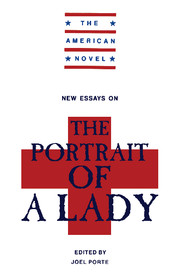Book contents
- Frontmatter
- Contents
- Series Editor's Preface
- A Note on the Text
- 1 Introduction: The Portrait of a Lady and “Felt Life”
- 2 The Portrait of a Lady and Modern Narrative
- 3 The Fatherless Heroine and the Filial Son: Deep Background for The Portrait of a Lady
- 4 The Portrait of a Lack
- 5 Frail Vessels and Vast Designs: A Psychoanalytic Portrait of Isabel Archer
- Notes on Contributors
- Selected Bibliography
2 - The Portrait of a Lady and Modern Narrative
Published online by Cambridge University Press: 04 August 2010
- Frontmatter
- Contents
- Series Editor's Preface
- A Note on the Text
- 1 Introduction: The Portrait of a Lady and “Felt Life”
- 2 The Portrait of a Lady and Modern Narrative
- 3 The Fatherless Heroine and the Filial Son: Deep Background for The Portrait of a Lady
- 4 The Portrait of a Lack
- 5 Frail Vessels and Vast Designs: A Psychoanalytic Portrait of Isabel Archer
- Notes on Contributors
- Selected Bibliography
Summary
THE publication of Madame Bovary in 1857 marks a turning point in narrative tradition. With Flaubert the novel, anticipating twentieth-century concerns, begins to reflect on itself: as Jean Rousset remarks, “it becomes critical and self-critical and it severs itself from the existing novel.”
Writers such as Steme and Diderot had already displayed a profound awareness of form by violating literary conventions to expose their artifice; but in the eighteenth century, the novel was a fluid, not yet rigorously codified form, a fact which makes Flaubert's position quite different from Sterne's and Diderot's. To oversimplify the history of the novel's form and of the concept of mimesis, we might say that during the eighteenth century and the first half of the nineteenth century, by presenting itself as an imitation of life and a mirror of mores, the novel had codified its form and had recognized its physiognomy and theoretical justification in realism. It is commonplace to put Balzac at the climax of this tradition: Eugénie Grandet was published in 1833 and l'Avantpropos to the Comédie Humaine in 1842. Flaubert then works against the backdrop of this established conception of the novel, a well-defined and strong tradition, and disrupts it from within. In doing so, he self-consciously places himself in a new tradition of critical reflection on and within the novel – the common denominator of experiments otherwise as diverse as those of Proust, Joyce, and Faulkner and which nowadays we see as the mark of twentieth-century art.
The text reclaims its self-referential nature – that is, its identity as an autonomous linguistic object governed by its own laws, rather than as a transparent vehicle between an external referent (the world, “reality”) and the reader.
- Type
- Chapter
- Information
- New Essays on 'The Portrait of a Lady' , pp. 33 - 48Publisher: Cambridge University PressPrint publication year: 1990
- 1
- Cited by

